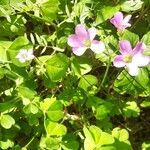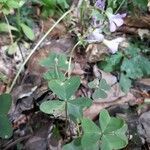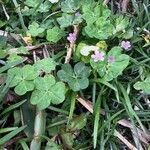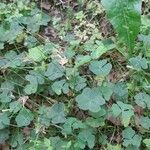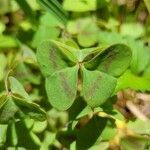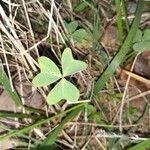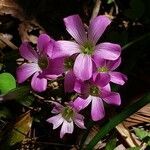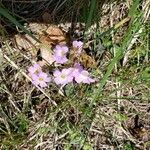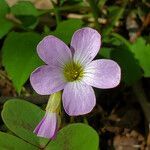Herbs perennial, acaulous, rhizomes usually absent, rarely present, <slender, scaly>, stolons absent, bulb solitary, bulblets at rhizome tips; bulb scales 3-nerved, <margins villous-ciliate on distal 1/3–1/2>. Leaves basal, <rarely absent at flowering>; petiole (4–)7–13(–24) cm; leaflets 3, green to purple abaxially, green adaxially, often with purplish, lateral band across lobes of each leaflet, rounded-obcordate to obreniform, (5–)8–15(–20) mm, lobed 1/4–1/3 length, <lobes apically convex>, surfaces glabrous, oxalate deposits in lines along margins at base of notch. Inflorescences umbelliform cymes, (1–)2–8(–19)-flowered; scapes (6–)9–23(–31) cm, glabrous. Flowers distylous; sepal apices with 2 orange, <linear, apically confluent> tubercles; petals white to pale green proximally with green veins, rose purple or lavender to pink or white distally, 10–18 mm. Capsules ovoid, 4–5 mm, glabrous. 2n = 28.
A herb which keeps growing from year to year. It is an erect, delicate plant. It grows 40 cm tall. The leaves grow from the base and have long stems. The leaves are divided into 3 leaflets. They are grey-green or bluish-grey above and a reddish-purple underneath. The leaves fold downwards and together at night and on cloudy days. There are 4-19 flowers at the end of each stem. They are pinkish-purple. The eye of the flower is usually a darker purple. The lobes of the petals spread out wide. They are 12-20 mm long. There are 5 petals and 10 stamens.
Perennial from a scaly bulbous base; lvs glabrous, or the petioles sometimes hairy; peduncles erect, 1–2 dm, much surpassing the lvs, with an umbelliform cluster of pedicellate fls subtended by small bracts; pet commonly rose-violet (white), 10–18 mm, not retuse; sep callous-tipped; 2n=28. Dry upland woods and prairies; Mass. to N.D., s. to Fla. and Tex. Apr.–June. (Ionoxalis v.)
